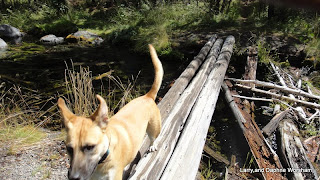What a difference a year can make. Looking back at our notes (see that post here), we stayed here at North Davis Creek on exactly the same dates in 2012. There is a noticeable difference in the water level in the lake portion, though the creek is still as boisterous as ever. I've put comparison photos in the album, to illustrate the difference.
 North Davis Creek campground is northeast of Davis lake, on the east side of highway 46, and actually feeds into a small arm on the west edge of Wickiup Reservoir. A bit of history here: The name Davis is taken from "Button" Davis, a nineteenth century stockman from the Prineville area who ran cattle in the vicinity of the lake. Davis Mountain, rising above the lake on the east side, was presumably named for the same man. In 1878 the name was already in use when Lt. T.W. Symons visited the area. His survey report included the first known description of the area, so this area has been well known for a long time, but it seems to have a lot less traffic that other lakes and other campgrounds in the general area, so we enjoy it for its quiet and natural beauty, and lack of traffic and crowds.
North Davis Creek campground is northeast of Davis lake, on the east side of highway 46, and actually feeds into a small arm on the west edge of Wickiup Reservoir. A bit of history here: The name Davis is taken from "Button" Davis, a nineteenth century stockman from the Prineville area who ran cattle in the vicinity of the lake. Davis Mountain, rising above the lake on the east side, was presumably named for the same man. In 1878 the name was already in use when Lt. T.W. Symons visited the area. His survey report included the first known description of the area, so this area has been well known for a long time, but it seems to have a lot less traffic that other lakes and other campgrounds in the general area, so we enjoy it for its quiet and natural beauty, and lack of traffic and crowds.What a beautiful campground! Several of the sites back up to the creeks, but site 7, the beach view site we stayed in last year, was available when we arrive, so who could resist? Arriving on Thursday we had the campground to ourselves until Saturday, when several sites were occupied. The place emptied out again on Sunday, so Monday and Tuesday morning were quiet, leaving only the occasional drive-through visitor to chat with.
 |
| Our campsite from the opposite bank |
I think it's safe to say that Shiner LOVES this campground. We forded the creek toward the east on Friday and explored the shore opposite our site. The shore, exposed now due to the low water, is soft silt, muddy in places, and the forest higher up on the shore is almost too dense to walk through...unless you are a deer at any rate. The only trails are made by the wildlife, so it's tricky to explore, but fun to see a view of things from across the water.
 |
| Investigating the source of the creek |
We walked across the basalt flow to get to the other side of the creek, and then tried out several of the many little log bridge routes.
 |
| Flying across the bridge |
There are at least 3 log bridges (depending on how generous your definition is); one between sites 10 and 11, a zigzag of three logs across the mouth of the little lagoon to the north shore, and the one connecting the campground to the shore near the lagoon at site 9. Shiner tried wading as well as actually walking on the logs, and is pretty good at both methods. Anything that leads to an adventure appeals to her!
Some ambitious exploration will reveal several outcrops of basalt, all sheltering water flows. Layers of moss, who knows how many generations deep, surround the quiet lagoon that has formed off to the north of the creek.
 |
| Sky and clouds reflected in the water underneath the moss |
If landscape can be "photogenic" this location definitely is. I know I took way too many photos of the creek, and of Shiner playing in it. She was having so much fun exploring it was tempting to try to capture all of her adventures, but she moves way too fast!!
The most abundant wildlife here is, no surprise, the golden mantle squirrel (chipmunk to most of us). These are Shiner's primary irritant as they know when she's on a leash and sit just out of reach, chattering at her. I guess you could consider it dog TV as it does keep her entertained.
Farther afield, across the creek, we spotted several deer and some very healthy looking coyotes (full of chipmunks no doubt). They never show up when the camera or binoculars are handy of course, so we just enjoyed watching them.
The days here were fairly warm and comfortable, but a couple of thunderstorms did their best to make it feel as though fall is already here, rather than just approaching. The second storm was complete with some fairly substantial hail. We didn't see any smoke on the horizon following either storm, a good thing, as there are already way too many fires burning in the state. Each night was a bit colder than the previous, with our last night here dipping down to 36 degrees. Yes, fall is definitely on the way.
More photos of our adventure here.
We're packing up on Tuesday morning and heading for Armitage Park in Eugene, to get things "civilized" and attend the first Duck football game of the season.... GOOOOOOO Ducks!!





































